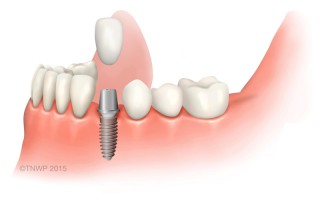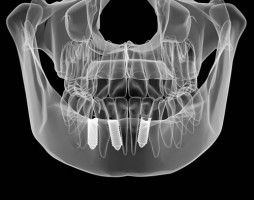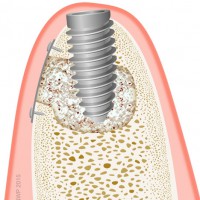Questions answered
- Dental implants to replace missing teeth
- Patient suitability for tooth implants
- Tooth implant treatments
- How dental implants work
- Cost of teeth implants
- Where to get dental implants
- Tooth implant procedures
- Bone grafting for dental implants
- Successful dental implant treatment
- Looking after tooth implants
[ TOP ] Dental implants to replace missing teeth
Page compiled with assistance from Dr Naresh Sharma

A tooth implant, or dental implant, is a replacement for a tooth root. Usually made from titanium, it is inserted into the jaw to hold a false tooth, bridge or denture in place.
A dental implant is inserted into the jaw under the gum. The implant is usually left to fuse with the jaw bone before a false tooth is fitted. This process is called osseointegration. It produces a secure bond between the tooth implant and the surrounding bone.
The first modern dental implant was placed in 1965. The design and materials have been much refined over the last 40 years with increasing success rates. Dental implants became widely available from the 1980s and millions have been successfully placed since then.
Dental implants have been used in clinical practice for many years. The materials have been rigorously tested. There are always risks with any surgical procedure. These partly depend on the patient and the operator. The pros and cons should be discussed with the implant dentist during the clinical consultation.
Tooth implants can last a lifetime, provided good oral hygiene and good general health are maintained. The crown, bridgework or denture they support may need replacing, due to normal wear and tear.
[ TOP ] Patient suitability for tooth implants
Page compiled with assistance from implant dentists

Most people can have dental implants, provided they have a healthy mouth and good general health. Tooth implants are not normally offered to young people whose jaws are still growing. Smoking and drinking alcohol can increase the risk of implant failure. There are also a number of medical conditions which can give an increased risk. These are discussed with each individual patient at the initial consultation.
In short, consult an implant dentist. Browse our directory using the map or postcode search. To assess whether you are suitable for tooth implants, the implant dentist will carry out a thorough clinical consultation. This will include a check of your medical history, a complete examination of your mouth and x-rays. You should discuss the treatment options with the dentist, who will provide you with a written treatment plan, including costs.
A healthy mouth is vital to the long-term success of teeth implants. Any dental problems, including gum disease, decay or other infections will need to be treated before the implants are placed.
Whether a patient can be treated with tooth implants depends on their general oral health and the amount of bone in the jaw. The implant dentist will carry out tests to check bone health and volume. If there is not enough, then bone grafting may need to be considered.
If the tooth root is infected, root canal or endodontic treatment may be possible. Where a healthy tooth is still in place, it can be fitted with a crown without the need for a dental implant. For missing teeth, the alternatives are a gap, a bridge or dentures.
Dental implants can provide a permanent replacement for missing tooth roots. The treatment is a cost-effective long-term investment. Bridges and dentures are cheaper in the short term, but have some disadvantages. Fitting a bridge usually involves removal of healthy material from adjacent teeth. The bone beneath a denture shrinks because it is not being used and chewing pressure reduces the blood supply. Dentures can be uncomfortable and cause problems with eating and speaking.
[ TOP ] Tooth implant treatments
Page compiled with assistance from Dr Duncan Ralston

Dental implants can be used to fill a single tooth gap, to replace multiple missing teeth or a complete set (known as a full arch) upper or lower. A single missing tooth can be replaced with a crown fitted to a dental implant. If you have two or more missing teeth, an implant-supported bridge could be used or multiple single implants and crowns.
If you have no teeth left there are two main options - a full arch bridge fixed in place using tooth implants or a conventional denture secured by two or more implants.
A single missing tooth needs one dental implant to replace it. If you have lost two or more adjacent teeth, you do not necessarily need an implant for every tooth. Dental implants can support a number of artificial teeth either in a bridge or denture. Four to six implants are usually needed to support a full top or bottom set.
A single dental implant and crown can normally be used to replace one missing tooth. An implant-supported crown looks and functions the same as a natural tooth. A major advantage, when compared to a conventional bridge, is that it does not involve any damage to the adjacent teeth. Filling the gap prevents undesirable movement of the adjacent and opposite teeth. To find out more, the next step is to arrange a consultation with an experienced implant dentist.
If all of your teeth are missing, there are two main options with dental implants:
Option1: A denture held in place by at least two tooth implants
If you already wear a denture, it can be prevented from moving around by implant locator clips. The denture can continue to be worn and removed for cleaning as normal.
Option 2: A full arch bridge supported by 4, 6 or 8 tooth implants
A permanently fixed full arch bridge can only be removed by a dentist. A clip retained bridge or denture can be removed by the wearer for cleaning, but is not as rigid as a fixed bridge.
If you have several teeth missing and you don't want to leave a big gap, the cheapest options in the short term are a bridge or a partial denture. With dental implant treatment the options are an implant-supported bridge or individual crowns fixed on a number of tooth implants. An implant-supported restoration will not damage the adjacent teeth. It will look and function the same as your natural teeth.
[ TOP ] How dental implants work
Page compiled with assistance from Dr Eilert Eilertsen

If a gap is created by missing adjacent teeth, at least two dental implants may be needed to support a multiple tooth bridge. The number of tooth implants needed depends on the size and position of the gap and the quality of the jaw bone. Consult a dentist to discuss the options for you.
The implants themselves are normally concealed beneath the gums. The only visible part of an implant-supported restoration should be the false teeth which comprise the crown, bridge or denture.
Most false teeth fitted to dental implants can only be removed by a dentist. Where implants are placed only to prevent a conventional denture moving around, the false teeth can continue to be removed for cleaning. A full arch bridge can be either permanently fixed or removable. The ANKYLOS SynCone system provides a solid base for the bridge, which can also be removed for cleaning.
Tooth implants can be placed next to natural teeth, provided the gap is big enough. Tooth implants look and operate just like the adjacent real teeth. Filling a tooth gap prevents distortion of the surrounding teeth positions. It also prevents shrinkage of the jaw bone underneath.
When several teeth implants are placed, they are normally joined together in the same way as a conventional bridge. Implant-supported teeth which are linked together are stronger, and stand up to wear and tear better.
[ TOP ] Cost of teeth implants

Tooth implants should be considered an investment. They are a cost-effective long-term solution to missing tooth roots. The initial outlay is higher than for a conventional denture or bridge. But, when properly maintained, teeth implants should last a lifetime.
Prices vary depending on the type of tooth implant treatment, the number of teeth that need replacing and the condition of the patient's mouth. Follow this link to see the results of a survey of fees for the most common treatments. Ask an implant dentist about your treatment options and costs.
Tooth implants can change patients' lives. They enable people to eat, speak, smile and laugh normally. Patients who have benefitted from the treatment seem to value the improvement. Typical comments include:
'Now I can laugh, smile, have a lot of fun and kiss with confidence'
'The finished implants and crowns look and feel like my own teeth, only better'
'The treatment has been worth every penny and I would recommend it to anybody'
Watch video interviews and read comments from patients who have had dental implant treatment.
Many practices offer payment plans, for patients who need to spread the cost. Check with the implant clinic when you have your initial consultation.
Teeth implants are only available on the National Health Service if there is a medical need for the treatment. People who have never had teeth or who have lost teeth through trauma or surgery may be considered. Consult your usual dentist for individual advice.
[ TOP ] Where to get dental implants
Page compiled with assistance from Dr Matthew Holyoak

It's easy to find an implant clinic, even if you are not currently registered with a dentist or if your usual dentist does not offer the treatment. You can browse our UK directory of implant dentists using the postcode search or the map on the left of this page.
The main reason some people go abroad for tooth implant treatment is a perceived cost saving. However, there are other factors to consider.
- Unless you are routinely spending long periods overseas, it may be more practical to have the treatment nearer to home
- Dental implant treatment often requires several visits to the clinic, which can be more convenient and less expensive if it is local
- Aftercare appointments may require more time off and expense
- Different countries may not have the same dentistry regulation standards as the UK
- If there is a problem with implants placed abroad, the costs for correction can be very high indeed
Probably the most important thing is finding the right implant dentist for you & a practitioner that you feel comfortable with and in whom you can have confidence.
Browse the directory of implant dentists using the postcode search or the map on the left of this page.
Provided the general dental practitioner has had the necessary training, they may offer tooth implant treatment. But, fewer than one in ten UK dentists have undergone the necessary training to place dental implants. If you are looking for an implant dentist locally, then search by your postcode on the left of this page.
The most common dental implant treatments can be completed by the patient's own general dental practitioner. The patient is referred to an implant clinic for the implant placement, then returned to their own dentist for the denture, bridge or crown to be fitted on top. If your own dentist does not already offer this treatment, you can find a dentist who provides the complete service by using the postcode search or the map on the left of this page.
The most common dental implant treatments can be completed by the patient's own general dental practitioner. The patient is referred to an implant clinic for the implant placement, then returned to their own dentist for the denture, bridge or crown to be fitted on top. If your own dentist does not already offer this treatment, you can find a dentist who provides the complete service by using the postcode search or the map on the left of this page.
[ TOP ] Tooth implant procedures
Page compiled with assistance from Dr Barry Tibbott

Nowadays, more than half of dental implant treatments can be completed on one day, which is known as 'immediate restoration'. The full staged treatment process is as follows:
- Diagnosis, consultation and treatment planning
- Any preparatory treatment to remaining teeth, extractions or bone grafting
- Placement of tooth implants and fitting of temporary false teeth
- Healing period of six weeks to six months followed by assessment
- Final fixed crown or bridge fitted three to nine months after implants placed
- Regular reviews to maintain health of gums, teeth and implants
Immediate restoration is when the crown, bridge or denture is fitted on top of a dental implant straight away. This enables the patient to be provided with replacement teeth on the same day. This can only be done when the implant has been placed into healed bone, ie the tooth has been extracted many weeks beforehand. Some precautions are needed after surgery to allow the implant to integrate successfully with the jaw bone. Not all cases are suitable for immediate restoration. At the treatment planning stage, patients need to discuss this option with the implant dentist.
Treatment times vary, depending on the type of dental implant procedure. Implant placement can only take a few hours but the entire process can take several months to complete. Treatment periods will be longer if bone grafting or other preparatory procedures are needed. The permanent false teeth are generally fitted three to nine months after the dental implants are placed.
Tooth implant treatment is generally carried out under local anaesthetic. If you are a nervous patient, your dentist might also offer an oral sedative or intravenous sedation to relax you during the treatment. Some complex cases will require a general anaesthetic.
Local anaesthetic and sedation are used during tooth implant surgery. After your treatment, you may experience some discomfort but your dentist will provide you with all necessary antibiotics and pain relief. Normally, any discomfort will last for only 24 hours. Patients often find that the procedure is less painful than having a tooth out.
Tooth implant surgery usually involves making a small incision into the gum. Just as with any surgery, there can be some discomfort. However, local anaesthetics and sedation virtually eliminate discomfort during the surgery. Post-operative pain will be similar to that of having teeth removed. You will be provided with medication to alleviate this.
You may be fitted with a temporary denture during the dental implant treatment process. If you already have full dentures, they can be modified to allow you to wear them whilst you are undergoing treatment.
[ TOP ] Bone grafting for dental implants
Page compiled with assistance from Dr Lucy Stock (nee Jaffa)

The vast majority of patients can have implants. If you do not have enough bone to have teeth implants straightaway, then bone grafting can be carried out. There are many different ways to plump out the bone and your implant dentist will discuss your options.
A tooth implant is a metal post that fits into the bone. The post needs enough height and width of bone to be placed. Bone grafting improves the amount of bone that you have, giving more support to the implant.
After you have a tooth out the gum and bone shrinks back, this is a natural process known as resorption. You may be able to feel your gum dip in or see a gap appearing between a bridge and your gum. It can be that a tooth abscess has eaten away the bone leaving a hollow which needs to be filled to allow an implant to be placed. Bone can also be lost due to gum disease which causes loose teeth. Other signs of bone loss are if a denture has loosened over time or your cheeks look more collapsed in.
After you have a tooth out the gum and bone shrinks back, this is a natural process known as resorption. You may be able to feel your gum dip in or see a gap appearing between a bridge and your gum. It can be that a tooth abscess has eaten away the bone leaving a hollow which needs filled to allow an implant to be placed. Bone can also be lost due to gum disease which causes loose teeth. Other signs of bone loss are if a denture has loosened over time or your cheeks look more collapsed in.
Bone from other areas of your mouth can be moved to where the implants are to be placed. Implant dentists routinely use bone out of packets which are often made from synthetic or animal products.
Implant dentists routinely use bone out of packets which are often made from synthetic or animal products.
The implant and bone graft can be placed the same day or the bone graft may be placed first, then left to mature for about 4-6 months before the implant is placed. When appropriate, temporary teeth can be made so you don't have a gap during treatment.
A thorough examination and x-rays give a lot of information on the amount of bone you have. In addition it may be recommended that you have a CT scan taken to provide more detail.
Just like when you stop going to the gym you lose muscle, it's the same idea for your jaw bone. If it's not being used then it shrinks and the more time that goes by the more bone you lose. Implants placed into the bone, work the bone and slow down the shrinkage process. This helps you to keep your face, lips and cheeks supported and looking youthful.
Bone grafting is a minor surgical procedure. Your comfort and success of the treatments are the priority. It is normal to have a bit of bruising, swelling and discomfort afterwards however many patients can be quite comfortable after having a bone graft.
[ TOP ] Successful dental implant treatment
Page compiled with assistance from Dr Andrew Greenwood

Osseointegration is where bone attaches to non-biological material, such as metal. In dentistry it is where the living bone bonds with the titanium tooth implant.
When a tooth implant fails, it is because there has been bone loss around the implant. This can be for a number of reasons, the most common are:
- Infection
- Poor oral hygiene
- Smoking and/or excessive alcohol consumption
- Grinding or gritting your teeth
- Other medical conditions, such as diabetes
The design of the implant and the skill of the dental surgeon in assessing your case are also factors in implant treatment success rates and aesthetic outcomes.
This is very rare. If the bone doesn't bond to the tooth implant, it will need to be removed. The jaw is then allowed to heal, before another implant is placed. There needs to be sufficient bone available to place another implant. In certain circumstances this means grafting some bone to increase the bone volume before the implants are placed. Your surgeon will decide when he assesses you how much bone you have.
Conventional dental restorations, such as bridges or dentures, can be used by patients who are found to be unsuitable for dental implants. Additional procedures such as bone grafts and sinus lifts may allow you to still have implants. Your surgeon will advise you of your suitability.
A CT (computerised tomography) scan gives the implant dentist a 3D image of the bone volume and shape of your jaws. The dentist can then assess whether the patient is suitable for tooth implant treatment. The scan may also be used to create a surgical guide to accurately place your implant.
Computer-aided dental implant surgery enables the dentist to place the implants more accurately, especially in complex cases. The technology allows the dentist to plan the surgery using a CT scan, specialist software and a surgical guide to accurately position your implants, making the process very precise.
CADCAM is computer-aided design and manufacturing. It ensures a streamlined digital workflow with greater control and accuracy over the final tooth. It can be used to pre-operatively assess the size of the tooth gap, design a virtual replacement tooth and use this to construct a surgical guide to help the surgeon position the implant. Subsequently it is used to design and manufacture the crown or bridge. It ensures a streamlined digital workflow with greater control and accuracy over the final tooth.
[ TOP ] Looking after tooth implants
Page compiled with assistance from Dr Don Weerasirie

The dental surgeon will advise you on what to do after tooth implant treatment. In general terms, you may wish to arrange for someone else to drive you home and avoid exercise for the rest of the day. You may not need to take time off work but you might wish to plan a day or two off as a precaution. Try not to have any big social or work commitments for a few days. On the day of surgery, do not rinse your mouth and only eat soft foods. Avoid tea, coffee, alcohol and spicy food. Brush your teeth, but avoid the tooth implant area and use a chlorhexidine mouthwash.
Looking after tooth implants is much the same as looking after your natural teeth. You should pay more attention to your implants and the area around them. To keep your implant teeth healthy, follow these simple steps:
- Brush twice daily
- Use a chlorhexidine mouthwash
- Floss regularly
- Have regular hygienist appointments
Looking after dental implants is much the same as looking after your natural teeth. You should pay more attention to your implants and the area around them. To keep your implant teeth healthy, follow these simple steps:
- Brush twice daily
- Use a chlorhexidine mouthwash
- Floss regularly
- Have regular hygienist appointments
Tooth implants need to be cleaned regularly, like natural teeth and conventional dentures. Removable dentures and removable full arch bridges can be taken out for cleaning. But, implant-supported fixed teeth, dentures and bridges can only be removed by a dentist.
Implant teeth can be cleaned like natural teeth and conventional dentures. Removable dentures and removable full arch bridges can be taken out for cleaning. But, implant-supported fixed teeth, dentures and bridges can only be removed by a dentist.
